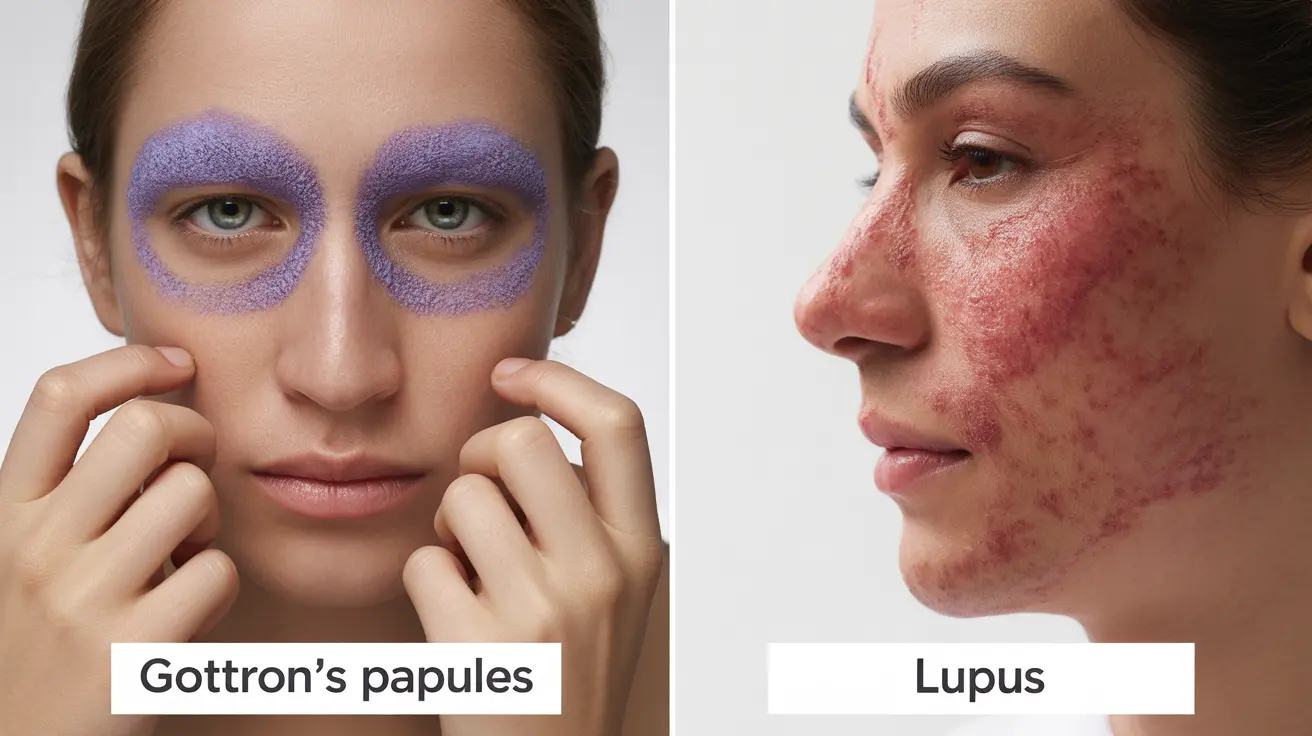Living with an autoimmune condition that causes skin rashes can be challenging, especially when trying to determine the exact cause. Two conditions that often create confusion due to their similar appearance are dermatomyositis and lupus. Understanding the distinct characteristics of each condition's rash and associated symptoms is crucial for proper diagnosis and treatment.
In this comprehensive guide, we'll explore the key differences between dermatomyositis and lupus rashes, along with their accompanying symptoms, diagnostic approaches, and management strategies.
Distinctive Characteristics of Dermatomyositis and Lupus Rashes
Dermatomyositis rashes typically present with unique features that set them apart from lupus rashes:
Dermatomyositis Rash Characteristics
- Purple-red, patchy rash on the face, particularly around the eyes (heliotrope rash)
- Gottron's papules over knuckles and joints
- Rash may appear on the chest, neck, and shoulders in a V-shape pattern
- Skin often becomes rough and scaly
- Noticeable nail fold changes with visible capillaries
Lupus Rash Characteristics
- Butterfly-shaped rash (malar rash) across the nose and cheeks
- Usually spares the nasolabial folds
- Can be triggered or worsened by sun exposure
- May appear on other sun-exposed areas
- Often accompanied by circular, discoid lesions
Associated Symptoms and System Involvement
While both conditions affect the skin, they have distinct patterns of system involvement that help in differentiation:
Dermatomyositis Symptoms
- Progressive muscle weakness, particularly in proximal muscles
- Difficulty climbing stairs or lifting arms above head
- Muscle pain and tenderness
- Difficulty swallowing (dysphagia)
- Calcium deposits under the skin (calcinosis)
Lupus Symptoms
- Joint pain and swelling
- Fatigue
- Fever
- Kidney problems
- Hair loss
- Blood disorders
Diagnostic Approaches
Healthcare providers use various methods to distinguish between these conditions:
- Blood tests for specific autoantibodies
- Muscle enzyme tests (particularly for dermatomyositis)
- Skin and muscle biopsies
- Comprehensive physical examination
- Electromyography (EMG) for muscle function assessment
Treatment Strategies and Management
Both conditions require tailored treatment approaches:
Medical Interventions
- Corticosteroids for inflammation control
- Immunosuppressive medications
- Antimalarial drugs (particularly for lupus)
- Physical therapy (especially important for dermatomyositis)
Lifestyle Management
- Sun protection and UV avoidance
- Regular exercise as tolerated
- Balanced nutrition
- Stress management
- Regular medical monitoring
Frequently Asked Questions
What are the key differences between a dermatomyositis rash and a lupus rash? The main differences lie in their appearance and location. Dermatomyositis typically presents with a purple-red rash around the eyes (heliotrope rash) and Gottron's papules over joints, while lupus features a butterfly-shaped rash across the nose and cheeks that typically spares the nasolabial folds.
How can I tell if my muscle weakness and rash are caused by dermatomyositis or lupus? Dermatomyositis typically causes significant muscle weakness, particularly in proximal muscles, along with its characteristic rash. While lupus can cause muscle pain, its primary symptoms often include joint pain, fatigue, and its distinctive butterfly rash.
What are the typical symptoms of dermatomyositis besides the skin rash? Besides the rash, key dermatomyositis symptoms include progressive muscle weakness, difficulty climbing stairs or raising arms, muscle pain, trouble swallowing, and possible calcium deposits under the skin.
How are dermatomyositis and lupus diagnosed and distinguished by doctors? Doctors use a combination of physical examination, blood tests for specific antibodies, muscle enzyme tests, skin or muscle biopsies, and EMG studies. The pattern of symptoms and test results helps distinguish between the conditions.
What treatments and lifestyle changes help manage rashes and symptoms in dermatomyositis and lupus? Treatment typically includes corticosteroids, immunosuppressants, and specific medications for each condition. Lifestyle changes include sun protection, regular exercise as tolerated, proper nutrition, and stress management. Regular medical monitoring is essential for both conditions.




